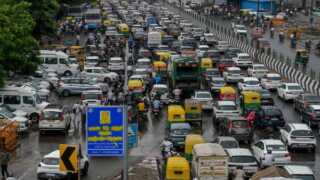Share via: According to the Federation of Automobile Dealers Associations (FADA), inventory levels touched 55 days by the end of July. …Read More According to the Federation of Automobile Dealers Associations (FADA), inventory levels touched 55 days by the end of July. (Amit Sharma) View Personalised Offers on Check Offers The Indian passenger vehicle industry is facing a subdued fiscal year, with ratings agency ICRA predicting only a 1–4 per cent growth in wholesale volumes. Cautious optimism comes after the first four months of FY25 (April–July) had a 1.1 per cent decrease in volumes. For an industry that has enjoyed a remarkable post-pandemic recovery, this slowdown is a reminder of the challenges that come with high inventory levels and the weight of last year’s strong base. Inventory worries and festive build-upDealers are already feeling the pressure of rising stockpiles. According to the Federation of Automobile Dealers Associations (FADA), inventory levels touched 55 days by the end of July. That is a worrying signal, especially with the festive season around the corner when automakers traditionally push wholesale volumes to keep production lines humming. Also Read : FASTag Annual Pass: Authority may face ₹4,500 crore burden, says ICRA The build-up is visible in the July numbers too, wholesale volumes grew 8.9 per cent sequentially as carmakers stocked dealerships ahead of Onam and the forthcoming festival cycle. But year-on-year, sales were flat at 3.4 lakh units. Retail sales told a similar story: a sequential rise of 10.4 per cent, but still down 0.8 per cent compared to July last year. SUVs still rule the roadIf there is one constant in India’s auto market, it is the dominance of SUVs. They now account for 65–66 per cent of overall passenger vehicle sales, and industry watchers believe this momentum will continue. The sheer variety of utility vehicles, spanning entry-level compact SUVs to premium three-row offerings, has kept customer interest alive even when small cars and sedans have slowed. For most manufacturers, SUVs remain the lifeline in an otherwise challenging market. Policy shifts may offer reliefOn the policy side too, there is light at the end of the tunnel. The central government has proposed possibly removing two of the four Goods and Services Tax (GST) slabs (5, 12, 18, and 28 per cent), leaving only two (5 and 18 per cent). If it goes ahead, it could provide some relief in price in some vehicle categories and might provide a boost to demand. Also Read : PV retail sales surge 2.45%, two-wheelers post 4.73% growth: FADA Exports provide a silver liningWhile domestic sales remain under pressure, exports are quietly offering some cheer. July saw a 9 per cent year-on-year jump in shipments, led by Maruti Suzuki and Hyundai Motor India. Though the base was low, it underlines the growing importance of overseas markets in cushioning Indian automakers from domestic volatility. Waiting for August numbersAll eyes are now on September 1, when carmakers are set to publish their August sales numbers. For an industry balancing optimism with caution, the next few months will be crucial. The festive season could determine whether FY25 ends as another year of solid growth, or just a pause in the industry’s long recovery run. Get insights into Upcoming Cars In India, Electric Vehicles, Upcoming Bikes in India and cutting-edge technology transforming the automotive landscape. First Published Date: 31 Aug 2025, 08:00 am IST
Source: hindustantimes.com






